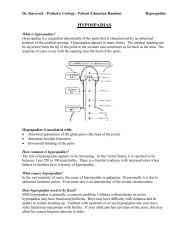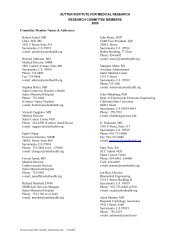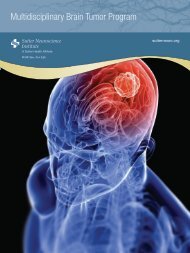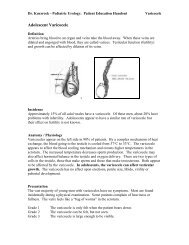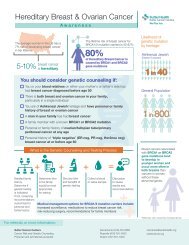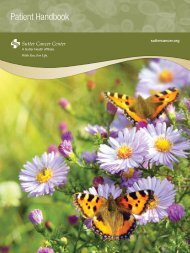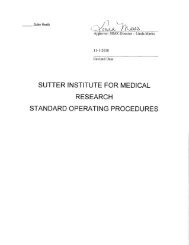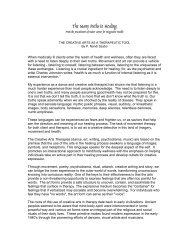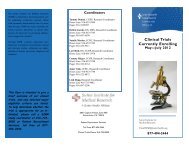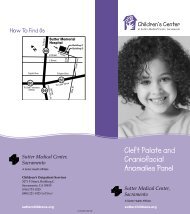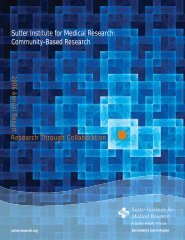Sutter Institute for Medical Research 2008 Annual Report
Sutter Institute for Medical Research 2008 Annual Report
Sutter Institute for Medical Research 2008 Annual Report
You also want an ePaper? Increase the reach of your titles
YUMPU automatically turns print PDFs into web optimized ePapers that Google loves.
<strong>Sutter</strong> <strong>Institute</strong> <strong>for</strong> <strong>Medical</strong> <strong>Research</strong><br />
<strong>2008</strong> <strong>Annual</strong> <strong>Report</strong><br />
Our Volunteers’ Perspectives<br />
sutterresearch.org
About SIMR<br />
Dedication<br />
Like most annual reports, ours<br />
typically focuses on <strong>Sutter</strong> <strong>Institute</strong> <strong>for</strong><br />
<strong>Medical</strong> <strong>Research</strong> (SIMR) activities<br />
and accomplishments. In this annual<br />
report, we have expanded the focus<br />
to include the reasons behind that<br />
work and what it has meant to a<br />
few of the many <strong>Sutter</strong> patients who<br />
have contributed the most critical<br />
element of the research equation<br />
by volunteering as clinical trial<br />
participants.<br />
No matter how hard any research team<br />
works, we could not advance medical<br />
care a single step without the trust and<br />
faith of clinical trial participants. By<br />
voluntarily contributing to improve<br />
medical care, participants touch<br />
the lives of people around the world<br />
and those yet to be born. And so it is<br />
with honor and appreciation that we<br />
dedicate this annual report to the<br />
research volunteers who work with<br />
us to further our mission “to integrate<br />
research into clinical care.”<br />
<strong>Sutter</strong> <strong>Institute</strong> <strong>for</strong> <strong>Medical</strong> <strong>Research</strong> (SIMR)<br />
provides a stable framework linking medical<br />
research with patient care. Through SIMR, <strong>Sutter</strong>affiliated<br />
physicians receive the administrative<br />
support and safety oversight needed to conduct<br />
prudent, successful research. SIMR was founded in<br />
1959 at Sacramento’s <strong>Sutter</strong> Memorial Hospital and<br />
now offers research opportunities throughout the<br />
<strong>Sutter</strong> Health Sacramento Sierra Region’s acutecare<br />
hospitals, and outpatient facilities involving<br />
both primary-care and specialty physicians.<br />
Our Mission<br />
To integrate research into clinical care.
Letter from the <strong>Medical</strong> and Operations Directors<br />
We’re delighted that this year’s annual report treats<br />
readers to the stories of four volunteers who have<br />
taken part in clinical trials through SIMR. Stories like<br />
these fuel the passion of our dedicated investigators<br />
and staff, and it’s that passion that drives SIMR<br />
<strong>for</strong>ward. Our volunteers’ journeys illustrate the value<br />
of providing research in a community hospital setting<br />
in a way nothing else could, so we thank Rael, Sharon,<br />
Kenneth and Jared’s families <strong>for</strong> agreeing to share their<br />
experiences.<br />
We also want to thank our investigators who spend long<br />
hours caring <strong>for</strong> patients, yet willingly increase their<br />
load by making medical research an important priority.<br />
As clinical practitioners, our investigators are not<br />
motivated by demands to publish or perish. They get<br />
involved in research <strong>for</strong> the same reason they entered<br />
the medical profession — to help people live longer,<br />
healthier lives. While SIMR staff does its utmost to<br />
remove the administrative work from the investigators,<br />
adding research to already busy lives requires a special<br />
dedication that we and their patients applaud.<br />
SIMR researchers presented at several national and<br />
international conferences.<br />
Even closer to home, our own SIMR research<br />
coordinators Tammy Donnel, Mary Hyland and Dorothy<br />
Wullenwaber became poster presenters at the 17th<br />
<strong>Annual</strong> Society of Clinical <strong>Research</strong> Associates. Their<br />
poster entitled “Implementation of Patient Recruitment<br />
Services Department in a Community Hospital Clinical<br />
<strong>Research</strong> <strong>Institute</strong>” was met with great interest. Patient<br />
recruitment is often the most difficult part of creating a<br />
successful clinical trial, so many attendees were anxious<br />
to find out more about SIMR’s successful recruitment<br />
system.<br />
With all systems running well, an exceptional staff and<br />
enthusiastic investigators, we have all the ingredients<br />
assembled to grow and strengthen the bond between<br />
research and clinical care.<br />
Sincerely,<br />
In addition to investigators involved in clinical trials,<br />
SIMR supports a special group of researchers who take<br />
a ground-up approach by designing and implementing<br />
research projects through SIMR’s <strong>Research</strong> Committee,<br />
led by Harvey Wolkov, M.D., with financial support<br />
from the <strong>Sutter</strong> <strong>Medical</strong> Center Foundation (SMCF).<br />
Over the years, the <strong>Research</strong> Committee and SMCF<br />
have enabled dozens of investigator-initiated studies<br />
to come to fruition, with many presenting findings<br />
through conference posters and presentations, as<br />
well as peer-reviewed publications. This year alone,<br />
Andrew Hudnut, M.D.<br />
<strong>Medical</strong> Director<br />
Linda D. Marks, MPA, CCRP<br />
Director, SIMR Operations<br />
John Mesic, M.D., CMO of<br />
<strong>Sutter</strong> Health Sacramento<br />
Sierra Region; Linda<br />
Marks, Director of SIMR<br />
Operations; Andrew<br />
Hudnut, M.D., SIMR<br />
<strong>Medical</strong> Director
Grant Enables SIMR to Pursue Key Goal<br />
We have long believed that SIMR’s uncommon<br />
position as a research entity within a community<br />
hospital system would make it possible to employ<br />
research to address issues that affect patients being<br />
cared <strong>for</strong> in several settings over an extended period<br />
of time. While most clinical research focuses on<br />
one aspect of diagnosis or treatment, patient care<br />
in the real world is a mixture of people, processes,<br />
medications and medical devices that each affects the<br />
patient’s outcome. In addition, conditions typically<br />
begin long be<strong>for</strong>e hospital admission and seldom<br />
completely resolve be<strong>for</strong>e hospital discharge. To<br />
determine the most effective diagnosis and treatment<br />
strategies, researchers must analyze the full care<br />
continuum, provide statistically meaningful results<br />
and translate those results into best practice models<br />
other health care providers can replicate.<br />
In <strong>2008</strong>, SIMR, the <strong>Sutter</strong> Health <strong>Institute</strong> <strong>for</strong><br />
<strong>Research</strong> and Education (SHIRE) and SHSSR Clinical<br />
Integrations received an unrestricted grant from<br />
sanofi-aventis to study the process of care <strong>for</strong> patients<br />
with or at risk of venous thromboembolism (VTE).<br />
Though sanofi-aventis produces drugs used to treat<br />
both conditions, this study is not tied in any way<br />
to any products, and the decision to publish lies<br />
solely with us. The study combines clinical research<br />
and business process engineering, working with<br />
key stakeholders to identify the ideal model of care,<br />
interviewing patients and conducting literature<br />
reviews. By analyzing each step along the care<br />
continuum and quantifying findings, the research<br />
team will develop a practical model shown to<br />
deliver the best outcomes in patients with a deep<br />
vein thrombosis or a pulmonary embolism. Once the<br />
model has been verified, the study includes funding to<br />
produce educational materials that will enable <strong>Sutter</strong> to<br />
disseminate the model across the system.<br />
According to Tom Leonard, grant manager <strong>for</strong> the study,<br />
“The study allows us to expand the nature, scope and<br />
purpose of research beyond clinical trials by examining<br />
the processes related to care. While businesses<br />
commonly develop and share best practices, health<br />
care providers only do so in segments that have been<br />
validated through research. In a sense, this takes the best<br />
of both disciplines by extending the rigors of research<br />
to all aspects of care, which will link the validated<br />
segments into a sequence of best practices.”<br />
Leonard adds, “This is very much a patient-centered<br />
study. We’ll look critically at our current practices and<br />
explore any blind spots so that the model we develop<br />
and disseminate raises the standard of care across our<br />
entire system. Of course, we’ll freely share the model<br />
through peer-reviewed publications and conference<br />
presentations so that other health care providers and<br />
their patients will also benefit from what we learn.”<br />
“The study allows<br />
us to expand the<br />
nature, scope and<br />
purpose of research<br />
beyond clinical trials<br />
by examining the<br />
processes related to<br />
care.”
<strong>Research</strong> and Training Laboratory<br />
SIMR Laboratory Staff<br />
Back row, left to right: Dr. Richard Marshall, Jim Steel.<br />
Front row, left to right: Alyson Iwamura, Liz Taylor, Todd Iwamura.<br />
The <strong>Sutter</strong> <strong>Institute</strong> <strong>for</strong> <strong>Medical</strong> <strong>Research</strong> (SIMR) has<br />
its origins in the research and training laboratory. In<br />
1957, Dr. Edward Smeloff founded the laboratory where<br />
he pioneered many early advances in cardiovascular<br />
surgery. Since that time, the laboratory department has<br />
kept <strong>Sutter</strong> on the cutting edge of developing and using<br />
new medical devices and techniques, maintaining a<br />
reputation <strong>for</strong> research excellence.<br />
Ed Smeloff, M.D., and Jimmy<br />
Durante visiting with the first ever<br />
pediatric recipient of the Smeloff-<br />
Cutter heart valve in 1963.<br />
In <strong>2008</strong>, the department conducted 204 research and<br />
training laboratories. In collaboration with 32 medical<br />
companies, the SIMR laboratory developed several<br />
cardiovascular devices to treat congestive heart failure,<br />
diseased valves, arrhythmias, arterial blockage,<br />
and strokes. In addition, three <strong>Sutter</strong> physicians are<br />
conducting independent orthopedic research: two are<br />
developing new spinal fixation devices and techniques,<br />
while the third is the inventor of the ROBODOC ® , the<br />
first device in medical history to combine surgery,<br />
imagery, and robotics. Other research ranges from<br />
developing new endosurgical instruments and<br />
techniques to treatments <strong>for</strong> sleep apnea and morbid<br />
obesity.<br />
To keep <strong>Sutter</strong> at the <strong>for</strong>efront of health care, the<br />
laboratory attracts the most progressive physicians,<br />
and continually trains its medical staff to use new<br />
technology and life-saving procedures. <strong>Sutter</strong> boasts<br />
one of the lowest infant mortality rates in the state<br />
of Cali<strong>for</strong>nia, partially because of the laboratory’s<br />
continual training in advanced life-support techniques.<br />
Other ongoing training sessions include minimally<br />
invasive surgery techniques, circulatory assist devices,<br />
and many others.<br />
The laboratory’s work in developing new medical<br />
devices and techniques improves patient safety<br />
and care, which result in shorter hospital stays and<br />
better outcomes, making health care better and more<br />
af<strong>for</strong>dable.
Less Invasive Surgery Synchronizes a Heart and Restarts a Life<br />
“Bring it on,” said Kenneth, a recently retired 62 year old<br />
who swims <strong>for</strong> 50 minutes several times a week. While<br />
that fitness level may be uncommon <strong>for</strong> men Kenneth’s<br />
age, it’s especially surprising <strong>for</strong> a man who had to rest<br />
after climbing a flight of stairs not long ago.<br />
It was during the holidays in 2001 that atrial fibrillation<br />
began causing Kenneth’s heart to erratically beat. The<br />
first serious bout sent him to the hospital, but he learned<br />
over time that sleeping usually restored the rhythm and<br />
he grudgingly adjusted his lifestyle to accommodate the<br />
breathlessness. He also started taking medications to<br />
control the symptoms and prevent the atrial fibrillation<br />
from causing a stroke, but he didn’t like relying on the<br />
medications to work without causing other problems.<br />
“I was getting ready to retire,” said Kenneth, “but my<br />
activity level had changed so dramatically that I wasn’t<br />
looking <strong>for</strong>ward to it.”<br />
Because the medications were not providing the relief<br />
Kenneth needed, electrophysiologist Larry Wolff, M.D.,<br />
talked to him about volunteering as a study participant<br />
<strong>for</strong> a minimally invasive surgery that cardiovascular<br />
surgeon James Longoria, M.D., was pioneering. He<br />
explained that instead of a traditional open heart<br />
“It took me<br />
four days to do<br />
what now<br />
takes four<br />
hours.”<br />
Cox Maze III surgery used to correct atrial fibrillation,<br />
Dr. Longoria would use probes placed through small<br />
incisions. Dr. Wolff would take part in the surgery,<br />
as well, doing interoperative mapping and testing to<br />
identify ganglionic plexi or areas of nerve tissue that<br />
innervate the heart and are felt to be responsible <strong>for</strong> the<br />
initiation and perpetuation of atrial fibrillation. Though<br />
Dr. Wolff thought Kenneth was an excellent candidate<br />
<strong>for</strong> the new procedure, which would involve smaller<br />
incisions and less scarring, less postoperative pain, and<br />
faster return to normal living than open heart surgery,<br />
Kenneth wasn’t ready to undergo any heart surgery.<br />
After another year of feeling that his life was on hold,<br />
Kenneth celebrated his 60th birthday and decided it was<br />
time <strong>for</strong> a tuneup.<br />
“About a week be<strong>for</strong>e my surgery, I was rototilling my<br />
yard,” said Kenneth. “I’d work <strong>for</strong> 10 minutes then rest,<br />
work <strong>for</strong> 10 minutes, then rest. It took me four days to do<br />
what now takes four hours.”<br />
Kenneth volunteered to be among the first to undergo<br />
the minimally invasive procedure with newly designed<br />
probes. During the three-hour surgery, Dr. Wolff and<br />
Dr. Longoria discovered that 13 of 26 areas needed to<br />
be ablated. Dr. Longoria ablated these areas, as well as<br />
per<strong>for</strong>med the pulmonary vein isolation. Two and half<br />
days after surgery, Kenneth went home to recover <strong>for</strong><br />
several weeks.<br />
While certainly less invasive than open-heart surgery,<br />
getting to the well-protected heart still requires that the<br />
ribs, muscles and nerves to be separated <strong>for</strong> the probes<br />
to pass through. Kenneth’s heart stopped misfiring<br />
immediately, and has remained steady since, but he<br />
had a bad reaction to the painkillers and the nerves<br />
and muscles took longer to heal than he hoped. As the<br />
procedure has continued to be perfected, recovery times<br />
have shortened, but Kenneth knows his recovery was still<br />
nothing compared to a friend who underwent open heart<br />
surgery about the same time.<br />
“Most important is how I feel,” Kenneth said.<br />
“Comparing my life be<strong>for</strong>e the surgery to after is like<br />
comparing night to day. I’m active again and in good<br />
shape — with absolutely no heart arrhythmia.”
Artificial Disc Puts Skier Back on the Slopes<br />
Rael was putting a piece of stone on a high shelf when<br />
she felt a twinge in her neck. An active 40-something<br />
woman who loved to ski, Rael was used to strained<br />
muscles and didn’t think much about the soreness in<br />
her neck that evening. When the pain increased instead<br />
of going away, Rael thought she had pinched a nerve<br />
and went to see her doctor, who sent her to a physical<br />
therapist.<br />
“Physical therapy only made the pain worse,” said Rael.<br />
“I also practiced breathing, relaxation and focusing<br />
exercises — anything I thought might help me deal with<br />
the pain.”<br />
In spite of everything she tried, the pain persisted and<br />
her once-active life slowed to an agonizing crawl. Three<br />
months after that first twinge, Rael underwent an MRI.<br />
The scan revealed a bulging disc pressing directly<br />
against the nerve roots of her spinal cord. Though glad<br />
to understand what was causing the pain, Rael also<br />
knew the most likely medical treatment would be to<br />
remove the disc and fuse her neck vertebrae, which<br />
would increase the risks of disease at other levels and<br />
potentially mean the end of skiing and many other<br />
activities she loved.<br />
That December, Rael went to neurosurgeon Cully Cobb,<br />
M.D., and immediately knew she’d found the right<br />
patient-doctor fit. “Dr. Cobb doesn’t think of surgery as<br />
the first option, which made me feel good,” said Rael,<br />
“and he really understood how important mobility<br />
is to me. When he told me about the possibility of<br />
volunteering to be part of a study <strong>for</strong> a new artificial<br />
cervical disc, I knew he wouldn’t have suggested it<br />
unless he felt confident that it was the best solution <strong>for</strong><br />
me. Even though I would be one of the first patients in<br />
the U.S. to get the device, Dr. Cobb, research coordinator<br />
Kimberly Olsen-Wilson and the device manufacturer<br />
were so thorough about making sure I was a good<br />
candidate that I never felt apprehensive.”<br />
Getting through the eight months it took to lay the<br />
groundwork <strong>for</strong> surgery proved to be much more<br />
difficult than the surgery. Rael went into surgery<br />
at eleven, woke up in recovery around two, and<br />
was standing up and walking by four o’clock. She<br />
went home the following morning and saw a daily<br />
“I feel as<br />
though I was<br />
never injured.”<br />
improvement over the next three weeks. The mental<br />
exercises that helped her manage the pre-surgery pain<br />
also enabled Rael to manage the post-surgery pain with<br />
nothing more than ibuprofen.<br />
“I hit a wall at three weeks,” Rael said, “but Dr. Cobb<br />
said that was part of the natural healing process my<br />
body was going through, so I just kept pushing through.<br />
By December I felt ready to ski again, but the doctors<br />
made me wait six months to ensure the new disc was<br />
firmly in place.” By the spring, six months after the<br />
surgery, Rael felt she had regained her pre-injury<br />
strength and stamina. The snow was gone <strong>for</strong> the year,<br />
but she was ready to go the following season.<br />
“I feel as though I was never injured,” she said, adding,<br />
“I have no loss of mobility, no pain, no lingering issues<br />
— none at all.”<br />
The five-year study requires Rael to get a yearly CT scan<br />
and X-rays to track her long-term healing, but it’s a sure<br />
bet that she’ll schedule those appointments be<strong>for</strong>e or<br />
after the ski season.
“I wasn’t the last one in line!”<br />
“Jared was 19 1/4 inches at birth and he seemed to<br />
get big fast,” said Allison, Jared’s mom. “But around a<br />
year, we started wondering if everything was okay. We<br />
noticed he wasn’t as big as his cousins and his clothes’<br />
sizes were always a year behind his age. The<br />
pediatrician said his size was normal, but when he<br />
started school, I heard a lot of comments about how<br />
small he was, and I noticed there were things he couldn’t<br />
do, like reach the sink to wash his hands. He noticed,<br />
too, and started asking what was wrong with him. By<br />
the time he turned five, Jared’s worry was apparent, so<br />
we decided to take him to see Dr. Prakasam.”<br />
Pediatric endocrinologist G. Prakasam, M.D., one of<br />
SIMR’s most dedicated research investigators, works<br />
with children and families dealing with all types of<br />
endocrine disorders. He knows that early detection and<br />
treatment of endocrine-related issues is important, but<br />
understands that children’s endocrine disorders are not<br />
always easy to diagnose and there’s a wider range of<br />
“normal” in children than adults. Clear-cut diagnostic<br />
tests are not always available <strong>for</strong> every disorder either,<br />
so it’s sometimes necessary to watch children over time<br />
and see how they develop. In Jared’s case, Dr. Prakasam<br />
per<strong>for</strong>med blood tests, took periodic hand X-rays to<br />
check growth, and followed Jared closely <strong>for</strong> more than<br />
two years be<strong>for</strong>e determining growth hormones were<br />
the best course of treatment.<br />
Un<strong>for</strong>tunately, even with health insurance, the cost of<br />
growth hormone treatment remains high. Dr. Prakasam<br />
offered Allison and her husband Kevin, the chance<br />
to enroll Jared as a volunteer in a clinical research<br />
trial. Though the drug was not yet FDA approved,<br />
Dr. Prakasam felt it showed good promise with few<br />
drawbacks.<br />
Best of all, Jared<br />
grew two and<br />
a half inches<br />
in the first six<br />
months of the<br />
study.<br />
“Enrolling Jared as a research volunteer was a very,<br />
very tough decision <strong>for</strong> us,” said Allison, “but we<br />
couldn’t af<strong>for</strong>d treatment otherwise. We also trusted Dr.<br />
Prakasam and knew he was very cautious, so we felt<br />
<strong>for</strong>tunate that this door had been opened <strong>for</strong> us. Jared<br />
has received such great care and been monitored so<br />
closely since he joined the study in May <strong>2008</strong>, that we<br />
know he’s getting excellent care and being seen more<br />
often than if we had chosen to do this on our own.”<br />
Best of all, Jared grew two and a half inches in the first<br />
six months of the study. “We’re ecstatic <strong>for</strong> him. It’s<br />
such a weight off his shoulders,” said Allison. “I don’t<br />
think I fully realized how much his size bothered him<br />
until I picked him up after school the day they took<br />
second grade pictures. Jared came running out to the car<br />
yelling, ‘I wasn’t last in line! I wasn’t last in line! I was<br />
second to last, but I wasn’t last!’”
“The results were<br />
everything I had<br />
hoped <strong>for</strong>.”<br />
Robotic-Assisted Hip Surgery Restores the Spring in Her Step<br />
While there’s no discounting the many benefits of<br />
aerobic exercise, teaching aerobics classes <strong>for</strong> countless<br />
years eventually took its toll on Sharon’s left hip. “In<br />
the type of aerobic dancing I taught, every step began<br />
on the left side,” said Sharon. “Over time, the constant<br />
pressure on my left hip gradually wore down the joint<br />
cartilage until it was bone on bone. It got to the point<br />
that I couldn’t even walk without limping.”<br />
Sharon talked to people who had undergone hip<br />
replacement surgery and heard Dr. Bargar’s name<br />
mentioned so often that she decided he was the one she<br />
wanted to per<strong>for</strong>m her surgery. In February <strong>2008</strong>, she<br />
went to see William Bargar, M.D., <strong>for</strong> the first time and<br />
heard that the latest generation of the robotic surgical<br />
assistant Dr. Bargar had helped develop many years<br />
be<strong>for</strong>e would soon be tested in a clinical trial.<br />
Dr. Bargar explained that the system would allow him<br />
to use diagnostic images to assess Sharon’s hip anatomy<br />
and condition, select the best hip implant type and size,<br />
and determine its optimal placement. During surgery,<br />
the system would assist him again, this time in carrying<br />
out the plan and preparing the femur <strong>for</strong> implant<br />
placement to ensure the implant was set at the correct<br />
angle. Dr. Bargar’s experience in hip replacement,<br />
combined with his confidence in the improved accuracy<br />
the system would provide over manual surgery<br />
techniques, convinced Sharon to enroll in the clinical<br />
trial.<br />
“The results were everything I had hoped <strong>for</strong>,” said<br />
Sharon. “I didn’t even have to take pain medication<br />
after the surgery. Eight or nine days after the surgery, I<br />
was able to walk up and down the stairs at home. My<br />
physical therapist said I could go down once in the<br />
morning and up again at night, and I was very careful<br />
to follow all instructions exactly, which I’m sure helped<br />
contribute to my results. My greatest fear was that the<br />
hip would pop out, but it settled right in and healed<br />
beautifully.”<br />
Today Sharon does not enjoy pain-free hips, however.<br />
“I do a lot of walking, and I can honestly say that I’ve<br />
never felt any pain in my left hip,” Sharon said, “but I<br />
have arthritis in my right hip now — and that’s the only<br />
hip that ever hurts.”
“There are a lot of unknowns in<br />
pediatric neurology and a great<br />
deal that can be learned by turning<br />
clinical observations into research<br />
studies that prove or disprove those<br />
observations. When I started seeing<br />
children with Down’s syndrome<br />
exhibiting signs of autism, I<br />
wondered if epileptic episodes might<br />
be occurring in these children.<br />
Working with SIMR allowed me to<br />
pursue that idea and verify that there<br />
may indeed be a connection. In fact,<br />
the opportunity to do research is one<br />
of the things that drew me to <strong>Sutter</strong>.<br />
There is a large patient population<br />
and ample support from SIMR to<br />
initiate, conduct and complete a<br />
research project.”<br />
Michael Chez, M.D.<br />
<strong>Medical</strong> Director, Pediatric Neurology<br />
Symposium Highlights<br />
One of the lesser-known opportunities SIMR<br />
provides is the chance <strong>for</strong> investigators to pursue<br />
research interests that lie outside clinical trials.<br />
Since 1989, dozens of physicians and other <strong>Sutter</strong><br />
practitioners have initiated research projects. In most<br />
instances, these researchers apply <strong>for</strong> and receive a<br />
grant funded by donations and other philanthropic<br />
gifts made by <strong>Sutter</strong> <strong>Medical</strong> Center Foundation.<br />
Over the years, many SIMR researchers have received<br />
national and international recognition <strong>for</strong> their work.<br />
In October <strong>2008</strong>, we gathered a few together <strong>for</strong> a<br />
local symposium presented to <strong>Sutter</strong> colleagues and<br />
members of the Greater Sacramento community. <strong>Research</strong><br />
scientist Carol Parise and SIMR staff members<br />
Bobbie Benabides, Dorothy Wullenwaber, Tammy<br />
Donnel, and Marilyn Dela Cruz, organized the symposium.<br />
Presentations were made by six researchers<br />
who recently completed studies with SIMR support:<br />
Nate Hitzeman, M.D.<br />
Affect of Personalized <strong>Annual</strong> Health Reminder Cards<br />
(PAHRC) on Completion of Age-Appropriate Health<br />
Maintenance Projective Objective<br />
A study to determine if personalized reminders of<br />
health maintenance items sent to patients on their<br />
birthdays would improve their completion of patient<br />
specific health maintenance requirements within six<br />
months. Results showed no increase from this lowcost<br />
intervention.<br />
Vincent Caggiano, M.D.<br />
Age, Race/Ethnicity, and Breast Cancer Subtypes in<br />
Cali<strong>for</strong>nia<br />
A series of studies conducted by analyzing 6,370<br />
records within the Cali<strong>for</strong>nia Cancer Registry<br />
database showing an invasive breast cancer<br />
subtype featuring negative receptors <strong>for</strong> estrogen,<br />
progesterone and human epidermal growth factor<br />
receptor 2 (triple negative). The widely published<br />
and presented studies conclusively showed that<br />
the subtype is more prevalent and deadly in<br />
young African American and Hispanic women, a<br />
finding that can help doctors look <strong>for</strong> and treat this<br />
challenging subtype.
Investigator-Initiated <strong>Research</strong><br />
Rosanna Hannum, R.N.<br />
Using Telemedicine to Manage Children Starting Insulin<br />
Pump Therapy<br />
A study to determine if telemedicine (medical care at<br />
a distance using technology) would improve access<br />
to care and affect the care standard in children with<br />
diabetes. The study showed telemedicine improved<br />
access to care, produced comparable treatment<br />
effectiveness and patient satisfaction. Current<br />
equipment costs and quality, maintenance costs, and<br />
lack of insurance reimbursement limit telemedicine’s<br />
feasibility at present. This is saying that telemedicine<br />
isn’t used because of the cost and insurance won’t<br />
reimburse <strong>for</strong> telemedicine visits.<br />
Michael Chez, M.D.<br />
Frequency of Abnormal Overnight EEG in Downs<br />
Syndrome Patients with Co-Morbid Diagnosis of Autism<br />
A study that grew out of Dr. Chez’s observation<br />
of an apparent link between Down’s syndrome<br />
children who developed autistic behavior and<br />
sleep abnormalities brought about by an epileptic<br />
process. The study of seven patients using a 24-hour<br />
electroencephalogram (EEG) showed brain wave<br />
disruption in four of the six who completed the<br />
test. Treatment with epilepsy medication created<br />
significant improvements in all four patients.<br />
Steve Weber, M.D.<br />
Pain Scores in the Management of Postoperative Pain in<br />
Shoulder Surgery<br />
An outcome study that tested the correlation between<br />
pain scores and patient outcomes. The study found that<br />
high pain scores did correlate to longer recovery times,<br />
but also found high pain scores were more common<br />
in certain patient populations and did not correlate<br />
with the magnitude of the operation or with heart rate,<br />
respiratory rate, or level of consciousness.<br />
William Bargar, M.D.<br />
Validation of Computer Navigation <strong>for</strong> Acetabular<br />
Component Placement in Total Hip Arthroplasty<br />
A study to determine the precision and accuracy of<br />
an imageless navigation system <strong>for</strong> correct placement<br />
during insertion of the acetabular cup in total hip<br />
replacement. The study showed high placement<br />
accuracy in patients with BMI scores of less that 35.<br />
The symposium drew a standing-room only crowd and<br />
a great deal of positive feedback from the audience.<br />
Supporting SIMR: We’re All in This Together<br />
<strong>Sutter</strong> <strong>Medical</strong> Center Foundation, the philanthropic arm of not-<strong>for</strong>-profit<br />
<strong>Sutter</strong> <strong>Medical</strong> Center, Sacramento, provides grants that enable <strong>Sutter</strong><br />
researchers to initiate and conduct quality research in a community<br />
hospital setting. By giving to the foundation, everyone in the community<br />
can take part in the excitement of advancing medical care through<br />
research.<br />
“<strong>Research</strong> funding is a critical investment in our future. The returns are<br />
immeasurable: new drugs, improved technology, and most important,<br />
better survival and quality of life <strong>for</strong> our patients and <strong>for</strong> people<br />
everywhere,” says Katherine Keeney, executive director of <strong>Sutter</strong> <strong>Medical</strong><br />
Center Foundation. “Safe, effective medical research requires more than<br />
the dedication of doctors, support staff and participants. The financial<br />
support we receive from our community through charitable donations<br />
to <strong>Sutter</strong> <strong>Medical</strong> Center Foundation helps SIMR to efficiently conduct<br />
research in a well-organized atmosphere that ably supports research<br />
participants, investigators and staff.”<br />
To contribute to the work <strong>Sutter</strong> <strong>Institute</strong> <strong>for</strong> <strong>Medical</strong> <strong>Research</strong> is to<br />
improve patient care in our community and beyond. Please contact the<br />
<strong>Sutter</strong> <strong>Medical</strong> Center Foundation at (916) 733-3863. You can find out<br />
more about the foundation at www.suttermedicalcenter.org/philanthopy.
2801 Capitol Ave., Suite 400<br />
Sacramento, CA 95816<br />
(916) 733-8930<br />
sutterresearch.org<br />
418209P 5/09 2500



